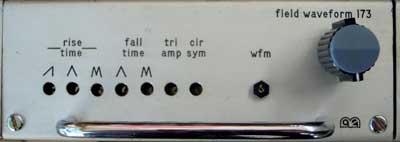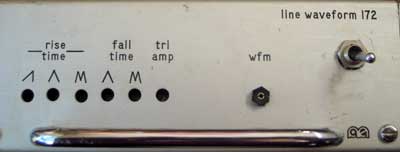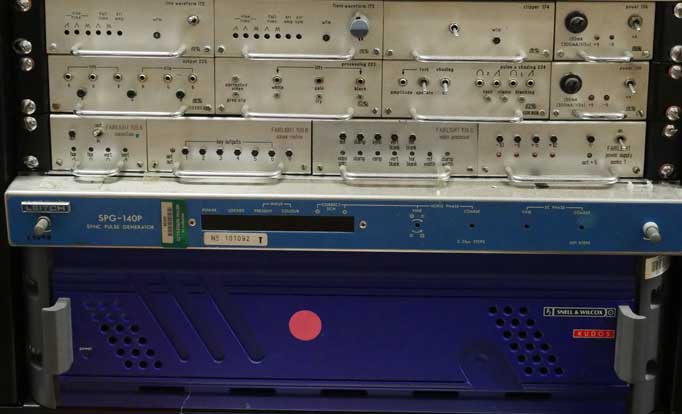Ian Andrews
Video
Analogue Video Synthesis Project (2015-16)
A piece made from an analogue video synthesiser constructed from line and field waveform modules salvaged from a Cox SES1000 analogue vision switcher triggered from audio and CV signals.

Home-built control panel for video synth made from 95% recycled materials and components.


Cox line and field waveform modules

Modules assembled in rackmount box with clipper/combiner and power supply.
History of Project
This project started, I suppose, in the early 1990s. I was working at Metro Screen in Paddington. There we had an old Michael Cox Electronics vision switcher (Special Effects Switcher 1000). After a heavy summer downfall the roof gave way and a large amount of water poured onto the control panel of the switcher, which was always powered 24 hours a day. The Panel was totally fried with close to 70 transistors requiring replacement as well as most of the very expensive to replace push button switches. I kept the old switcher mainframe which being kept in a separate central apparatus room survived the incursion. I had plans to use the wipe waveform boards to build some sort of video synthesiser. The nice thing about the Cox hardware is that it's very modular. The boards for the switcher were built into a large box of 12 (if I remember) single rackmount units. Each unit has its own power supply and is made up of either three standard modules, or sometimes one standard and one double width module. The other nice thing about Cox equipment is that it is very well designed, broadcast spec, easy to work on—with extender boards in a rack, or with top or bottom covers removed when not in a rack—and really well documented with very detailed descriptions of the circuits involved (e.g. 'theory of operation' type stuff).
Cox was a UK company. In Australia we had a company called Fairlight. In their early analogue equipment they copied the Cox modular design (or perhaps they both copied Link/Prowest).
Several Years later I acquired 14 or so different pieces of Cox equipment at an auction, most of which were in 1 rack unit boxes. These included PAL encoders, a Coxbox IV colouriser and its preset panel, encoded chroma key, RGB chroma key, a downstream keyer, some VITS colour bar units, and some testing/lineup boxes. Apart from some useful equipment, such as the Coxbox IV and the coders, I had some less useful boxes to use just for the boxes themselves so that I could install the switcher cards in a smaller profile than the 12 RU switcher frame. I took the three modules that generate and combine the wipe waveforms: the 172 Line Waveform module, 173 Field Waveform module, and 174 Clipper module, and put them in an old PAL encoder box with the standard +9V -9V power supply.
The waveforms are generated from the incoming composite sync signal so I had to have a sync pulse generator. I used a Leitch SPG-140P sync pulse gernerator for this.
The non-composite signal from the clipper module is then fed into the Cox Box IV colouriser. Unfortunately I didn't get the control panel for the Coxbox IV but I managed to track down the circuit diagram and built my own.
The output of the Coxbox IV is RGB so it needs to be fed into a PAL encoder to get a composite PAL signal, or a transcoder to go to component Y, R-Y, B-Y. I modified an old Fairlight encoder to do this many years ago but it does not seem to be working at the moment. Recently I obtained a Snell & Wilcox ADC box that converts RGB + sync to SDI. It also contains a D to A encoder tha converts SDI to composite so I can get both signals.
It's important to point out that much of the emphasis of this project lies in recycling. All of this equipment would certainly have found its way into landfill if it had not been reserved for this project. Most of the components used in the control interfaces have been recycled from other pieces of equipment. All but one of the pots on the synthesiser control panel were pulled out of other gear (they are beautiful little conductive plastic pots that would have cost $15 to $30 each if I had bought them new). All of the switches have been reused. The panel hardware, wire, screws, Perspex and wood are have all been salvaged from other stuff. Only the 3.5mm sockets, the capacitors and some of the wire were bought new.

Rack of components that make up the video synthesiser: synthesiser unit made up of Cox line and field waveform modules; Cox Box IV colouriser; Fairlight colouriser; Leitch SPG; Snell & Wilcox ADC unit.